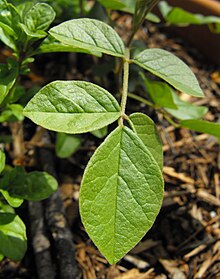
Summary
Glycyrrhiza uralensis, also known as Chinese liquorice,[2] is a flowering plant native to Asia. It is used as a sweetener and in traditional Chinese medicine.[3]
| Glycyrrhiza uralensis | |
|---|---|

| |
| Scientific classification | |
| Kingdom: | Plantae |
| Clade: | Tracheophytes |
| Clade: | Angiosperms |
| Clade: | Eudicots |
| Clade: | Rosids |
| Order: | Fabales |
| Family: | Fabaceae |
| Subfamily: | Faboideae |
| Genus: | Glycyrrhiza |
| Species: | G. uralensis
|
| Binomial name | |
| Glycyrrhiza uralensis | |
| Synonyms[1] | |
| |
Traditional uses edit
Liquorice root, or 'radix glycyrrhizae', is one of the 50 fundamental herbs used in traditional Chinese medicine, where it has the name gancao (kan-tsao; Chinese: 甘草, pinyin: gāncǎo). It is used in Chinese medicine to harmonize other herbs and to reduce the harsh effects of other herbs.[3] It is usually collected in spring and autumn, when it is sliced and sun-dried, then either used unprepared or stir-baked with honey.[4] Liquorice root is most commonly produced in the Shanxi, Gansu and Xinjiang regions of China.[5]
Side effects edit
Liquorice root contains glycyrrhizin, which may affect blood pressure, blood potassium levels or have untoward effects during pregnancy.[6] Overuse of licorice may induce weakness, headache, blurred vision, nosebleed, anxiety, or shortness of breath.[7] Other common side effects may include missed menstrual periods, fluid retention or sexual problems in men.[7] More serious instances of overuse can lead to hypertension and hyperaldosteronism, which may require hospitalization.[8]
Plant description edit
Harvesting and growth edit
Glycyrrhiza uralensis can be found growing naturally in Europe, Asia, and throughout the Middle East. This Chinese licorice is harvested mainly during the spring and autumn and is dried by sunlight. The plant is very strong rooted, and grow to be 30-120 cm tall.[9]
Chemistry edit
The plant contains a glycoside that is 30-50 times sweeter than sucrose, glycyrrhizin, which has the chemical composition C42H62O16.[10][11] The plant contains numerous phytochemicals.[11]
See also edit
References edit
- ^ The Plant List: A Working List of All Plant Species, retrieved 7 March 2017
- ^ "Glycyrrhiza uralensis". Germplasm Resources Information Network. Agricultural Research Service, United States Department of Agriculture. Retrieved 30 August 2011.
- ^ a b Plants for a Future, retrieved 8 March 2017
- ^ Wu, Jing-Nuan (2005). An Illustrated Chinese Materia Medica. Oxford, UK: Oxford University Press. p. 344.
- ^ “Gan Cao.” Chinese Medical Herbology and Pharmacology. "Archived copy" (PDF). Archived (PDF) from the original on 2016-03-31. Retrieved 2010-07-20.
{{cite web}}: CS1 maint: archived copy as title (link). 25 April 2010. - ^ "Licorice Root". National Center for Complementary and Integrative Health, US National Institutes of Health. 1 September 2016. Retrieved 1 April 2019.
- ^ a b "Licorice". Drugs.com. 14 October 2018. Retrieved 1 April 2019.
- ^ Omar, Hesham R.; Komarova, Irina; El-Ghonemi, Mohamed; Fathy, Ahmed; Rashad, Rania; Abdelmalak, Hany D.; Yerramadha, Muralidhar Reddy; Ali, Yaseen; Helal, Engy; Camporesi, Enrico M. (2012). "Licorice abuse: time to send a warning message". Therapeutic Advances in Endocrinology and Metabolism. 3 (4): 125–138. doi:10.1177/2042018812454322. ISSN 2042-0188. PMC 3498851. PMID 23185686.
- ^ Chang, Sue-Joan; Chan, Yin-Ching; Yu, Wen-Jen (2015), "Glycyrrhiza uralensis 甘草 (Gancao, Licorice)", Dietary Chinese Herbs, Vienna: Springer Vienna, pp. 135–145, doi:10.1007/978-3-211-99448-1_14, ISBN 978-3-211-99447-4, retrieved 2022-11-28
- ^ "Glycyrrhizin - an overview | ScienceDirect Topics". www.sciencedirect.com. Retrieved 2022-11-30.
- ^ a b PubChem. "Glycyrrhizin". pubchem.ncbi.nlm.nih.gov. Retrieved 2022-11-28.
External links edit
- Spice Pages: liquorice (Glycyrrhiza glabra/uralensis, liquorice)
- Science Direct
- Journal of Chinese Integrative Medicine[permanent dead link]
- Radix Glycyrrhizae at damo-qigong.net


